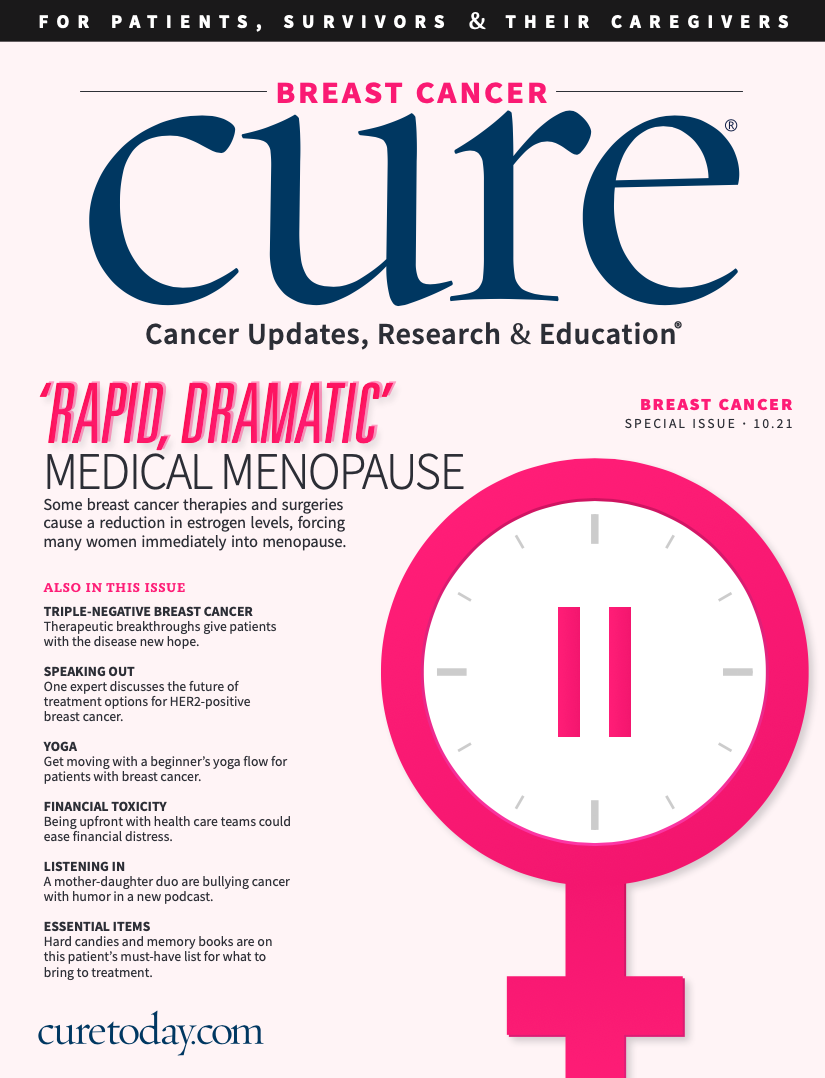Publication
Article
CURE
Long-Term Data Show The Impact of Herceptin On Treating HER2-Positive Breast Cancer
Author(s):
More than 10 years of follow-up data have shown that combining Herceptin with chemotherapy is safer and more effective than chemotherapy alone in this patient population.
The combination treatment of Herceptin (trastuzumab) and chemotherapy for early-stage, HER2-positive breast cancer may reduce the recur- rence of — and mortality from — the disease by a third, according to study results.
“It’s really important because when a patient gets a diagnosis of HER2-positive breast cancer, immediately the first thought is, ‘This is so bad.’ This is one of the more aggressive cancers. I believe this is why it’s so important to understand that trastuzumab has changed the way we think about HER2-positive breast cancer. This study showed the significant positive impact trastuzumab has had on outcomes in HER2-positive breast cancer,” said Dr. Zahi Mitri, an assistant professor of medicine in the Division of Hematology and Medical Oncology at OHSU Knight Cancer Institute in Portland, Oregon, in an interview with CURE®. “Patients can actually be confident that their treatment can help them really beat this cancer because this study follows patients for not one or two years, but up to a 10-year follow-up for most patients.”
Of note, HER2-positive breast cancer accounts for 10% to 20% of early-stage breast cancer diagnoses annually.
“One of the biggest takeaways is ... the treatment historically had been chemotherapy alone. And with chemotherapy, alone, we had seen a lot of risk of breast cancer coming back. But ... this study shows that the addition of one drug, trastuzumab, has reduced the risk of breast cancer coming back, and that actually translated into (fewer) people dying of HER2-positive breast cancer,” Mitri said.
Seven trials that assessed chemotherapy plus Herceptin versus chemotherapy alone were included in the study, which had 13,864 participants. The mean scheduled treatment duration was 14.4 months with a median follow-up of 10.7 years. Researchers reported that the risks of breast cancer recurrence, as well as death from breast cancer, were lower with the group treated with Herceptin plus chemotherapy. At 10 years, recurrence risk was reduced by 9%, and mortality rate was reduced by 6.4%.
“It is as clear as it can be that adding the anti-HER2 treatment trastuzumab to chemotherapy and other strategies definitely improved survival for patients with early-stage breast cancer,” said Dr. Edith Perez, a professor of medicine at Mayo Clinic in Jacksonville, Florida, and chief medical officer at Bolt Biotherapeutics, a biotechnology company that focuses on cancer immunotherapy.
Perez, whose trial was one of the seven in the study, said that prior to these results patients didn’t have options for a targeted therapy against HER2 in the early-stage setting. “And I think it exemplifies what can be accomplished with good science and good research and good patient participation in trials,” she said.
In comparison with chemotherapy, Herceptin also had very manageable side effects. “The biggest side effect that we could see — that we monitor for — is an impact on the heart muscle, (which) is rare, meaning single digit. (Fewer) than 10% of (patients) will have an impact on the heart muscle function. And more importantly, it is reversible. ... With interrupting the treatment, it can recover,” Mitri explained, noting that the treatment also doesn’t lead to high risks of infection, nor does it require what he calls “premedication” such as steroids or nausea medication. “I think patients have tolerated this beautifully.”
Mitri added, however, that many of the studies included in the trial used anthracycline-based chemo- therapy — also known as the red devil for side effects such as increased risk for heart damage — which generally has been removed from treatment for this patient subset due to novel effective non-anthracycline regimens.
Herceptin can be given with other chemotherapy agents, or even after chemotherapy as a single agent. “Since we demonstrated the trastuzumab added to the benefit of chemotherapy, further advances have continued in terms of adding a second type of anti- HER2 therapy,” Perez said. “I think the message is that finding cures for cancer ... it’s really a journey. But as we go through the journey, significant progress is being made. And many patients today are cured of HER2-positive breast cancer who would not otherwise have been cured if trastuzumab had not become available.”
For more news on cancer updates, research and education, don’t forget to subscribe to CURE®’s newsletters here.





